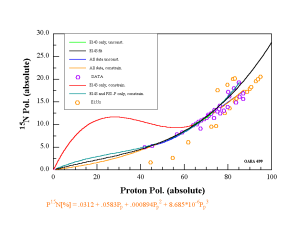Historic Information
During SMC the measurement of the N14 polarization was performed[1], also shown in earlier measurements [2]. The measurement indicated that equal spin temperature (EST) is obeyed. With coupled systems like this that obey EST one knows what the nuclear polarization of one given the other. So no real need to measure the polarization of nitrogen in real-time if you know what the proton polarization is. At SLAC, a measurement of N15 where the ammonia spin is carried by the proton also found agreement with EST. N15D3 was used for the measurement of the spin structure of the neutron. Because the spin of N15 is carried by the proton there is reduced background subtraction for observables like g1 and g2 for proton and neutron. For this reason, ammonia that uses nitrogen-15 is a better target and the corrections for an example observable can be found in [3,4]. This approach is very reasonable given some knowledge of the nitrogen cross-section for the process of interest. For DIS both the cross-section and the partonic effect of the nuclei polarization to the overall asymmetry were known enough to make these corrections to the asymmetry after the experiment. These corrections in general are just a couple of percent (relative) to the overall asymmetry. We must consider a similar lack of detail for the proton J/psi production cross-section. In the early days, the nitrogen cross-section were not well known for DIS, so tricks with C12 and cross-section generators were used to estimate the nitrogen cross-section. Such tools can be extended to other processes but there is great ambiguity in the accuracy of such approaches especially for TMDs.
A modern Approach
For processes where the cross-section of nitrogen is not known corrections are harder to apply. It's still possible to get nitrogen cross-section information from a generator like MCFM but this is theoretical in nature and likely, not the best option. The other issue is the lack of theoretical and even conceptual understanding of how polarized nuclei change the scale of an observables at hand, like the Sivers asymmetry. Unlike the standard colinear probing processes, TMDs from either Drell-Yan or Semi-inclusive DIS may have large correlations induced by partonic dynamics from nuclei in close proximity. More experimental information is needed. It's possible to estimate the contribution in this regard in a similar vein outline previously but this requires some pretty big assumptions. Another approach is to use the modern tools available in RF and NMR technology. The most basic approach is to modulate across the NMR signal of the polarized nitrogen at high RF power, forcing transitions to mitigate polarization during the DNP process of the protons (or deuterons) in the target. Such tools were first suggested in [6] and later experimentally tested in [7]. These tools require additional RF coils at the target and/or amplification at the NMR coils. Such tools can be fully integrated into an NMR system for fast sweep control, accurate polarization measurement and simultaneous manipulation. Such a system is not presently set up for SpinQuest. In this case, not being a priority at the moment a measure of the nitrogen-14 cross-section would be beneficial in the initial set of runs. This is a non-trivial measurement and must obviously be atmosphere free and using the frozen state nitrogen which is preferred for safety and density.
Some results from Oscar A. Rondon
Plots of world data on 15N vs proton polarization in ammonia, with fits to all data (fit function shown; .pdf and .gif file formats) and to SLAC E143&PSI (+polarization only). The individual data are identified in the plot showing only the E143&PSI+ fit. The data are in the attached text file n15ppol.txt, if anyone would like to try other fits. The data come from Don (E143 and PSI, digitized from plot) and Stephen Bueltmann (SLAC E155x).
References
1.) NitrogenPol.pdf [Measurement of Proton and Nitrogen Polarization in Ammonia and a Test of Equal Spin Temperature][CERN-PPE/97-66(June16,1997) ]
2.) 1-s2.0-0168900286908181-main.pdf [THE POLARISATION OF I4N AND l5N NUCLEI IN POLARISED PROTON TARGETS USING IRRADIATED AMMONIA ][G.R. COURT and W.G. HEYES (1985)]
3.) n15corr4.pdf [The 15N correction to the measured asymmetries] [M. Jones [TNJAF], Oscar A. Rondon [INPP-UVA] (RSS T.N. #2005-01 (June1, 2011)) ]
4.) PhysRevC.60.035201.pdf [Corrections to Spin Structure Asymmetries Measured in Nuclear Polarized Targets]
5.) EPJ_spin.pdf
7.) dfpf_writeup.pdf [The packing fraction and dilution factor in RSS] Oscar A. Rondon [INPP-UVA] (RSS T.N. #2005-03 (January 13, 2006)) ]
"RSS TN 005-03 is a follow-up to the 15N correction RSS TN, ref. 3. above. Since the DF is given in terms of cross section ratios, I believe it should apply to any type of scattering (DIS, nuclear, D-Y) as long as the appropriate cross section ratios are used. One item that may be of interest to Spinquest is that the target packing fraction might be measured by comparing rates of muons scattering on C disk targets of known thicknesses to rates on the NH3 target, and a Montecarlo of NH3+LHe that's calibrated with the C data. But I don't know if a reliable muon beam could be transported to the experimental area at Fermilab." ~ Oscar Rondon
8) References from [https://userweb.jlab.org/~jones/rss/] [Jlab Experiment E01-006: Resonances Spin Structure (RSS)]
9.) References from SANE wiki [https://hallcweb.jlab.org/experiments/sane/wiki/index.php/Main_Page]
